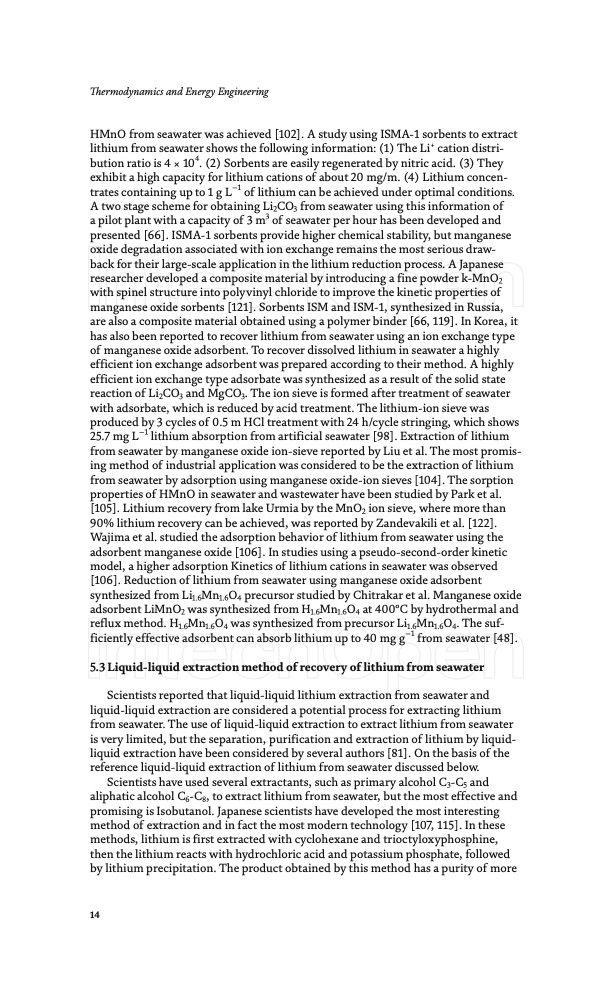
PDF Publication Title:
Text from PDF Page: 016
Thermodynamics and Energy Engineering HMnO from seawater was achieved [102]. A study using ISMA-1 sorbents to extract lithium from seawater shows the following information: (1) The Li+ cation distri- bution ratio is 4 × 104. (2) Sorbents are easily regenerated by nitric acid. (3) They exhibit a high capacity for lithium cations of about 20 mg/m. (4) Lithium concen- trates containing up to 1 g L−1 of lithium can be achieved under optimal conditions. A two stage scheme for obtaining Li2CO3 from seawater using this information of a pilot plant with a capacity of 3 m3 of seawater per hour has been developed and presented [66]. ISMA-1 sorbents provide higher chemical stability, but manganese oxide degradation associated with ion exchange remains the most serious draw- back for their large-scale application in the lithium reduction process. A Japanese researcher developed a composite material by introducing a fine powder k-MnO2 with spinel structure into polyvinyl chloride to improve the kinetic properties of manganese oxide sorbents [121]. Sorbents ISM and ISM-1, synthesized in Russia, are also a composite material obtained using a polymer binder [66, 119]. In Korea, it has also been reported to recover lithium from seawater using an ion exchange type of manganese oxide adsorbent. To recover dissolved lithium in seawater a highly efficient ion exchange adsorbent was prepared according to their method. A highly efficient ion exchange type adsorbate was synthesized as a result of the solid state reaction of Li2CO3 and MgCO3. The ion sieve is formed after treatment of seawater with adsorbate, which is reduced by acid treatment. The lithium-ion sieve was produced by 3 cycles of 0.5 m HCl treatment with 24 h/cycle stringing, which shows 25.7 mg L−1 lithium absorption from artificial seawater [98]. Extraction of lithium from seawater by manganese oxide ion-sieve reported by Liu et al. The most promis- ing method of industrial application was considered to be the extraction of lithium from seawater by adsorption using manganese oxide-ion sieves [104]. The sorption properties of HMnO in seawater and wastewater have been studied by Park et al. [105]. Lithium recovery from lake Urmia by the MnO2 ion sieve, where more than 90% lithium recovery can be achieved, was reported by Zandevakili et al. [122]. Wajima et al. studied the adsorption behavior of lithium from seawater using the adsorbent manganese oxide [106]. In studies using a pseudo-second-order kinetic model, a higher adsorption Kinetics of lithium cations in seawater was observed [106]. Reduction of lithium from seawater using manganese oxide adsorbent synthesized from Li1.6Mn1.6O4 precursor studied by Chitrakar et al. Manganese oxide adsorbent LiMnO2 was synthesized from H1.6Mn1.6O4 at 400°C by hydrothermal and reflux method. H1.6Mn1.6O4 was synthesized from precursor Li1.6Mn1.6O4. The suf- ficiently effective adsorbent can absorb lithium up to 40 mg g−1 from seawater [48]. 5.3 Liquid-liquid extraction method of recovery of lithium from seawater Scientists reported that liquid-liquid lithium extraction from seawater and liquid-liquid extraction are considered a potential process for extracting lithium from seawater. The use of liquid-liquid extraction to extract lithium from seawater is very limited, but the separation, purification and extraction of lithium by liquid- liquid extraction have been considered by several authors [81]. On the basis of the reference liquid-liquid extraction of lithium from seawater discussed below. Scientists have used several extractants, such as primary alcohol C3-C5 and aliphatic alcohol C6-C8, to extract lithium from seawater, but the most effective and promising is Isobutanol. Japanese scientists have developed the most interesting method of extraction and in fact the most modern technology [107, 115]. In these methods, lithium is first extracted with cyclohexane and trioctyloxyphosphine, then the lithium reacts with hydrochloric acid and potassium phosphate, followed by lithium precipitation. The product obtained by this method has a purity of more 14PDF Image | Lithium Recovery from Seawater Salt Lake Brine

PDF Search Title:
Lithium Recovery from Seawater Salt Lake BrineOriginal File Name Searched:
IntechOpenSamadiyBookchapter.pdfDIY PDF Search: Google It | Yahoo | Bing
Product and Development Focus for Infinity Turbine
ORC Waste Heat Turbine and ORC System Build Plans: All turbine plans are $10,000 each. This allows you to build a system and then consider licensing for production after you have completed and tested a unit.Redox Flow Battery Technology: With the advent of the new USA tax credits for producing and selling batteries ($35/kW) we are focussing on a simple flow battery using shipping containers as the modular electrolyte storage units with tax credits up to $140,000 per system. Our main focus is on the salt battery. This battery can be used for both thermal and electrical storage applications. We call it the Cogeneration Battery or Cogen Battery. One project is converting salt (brine) based water conditioners to simultaneously produce power. In addition, there are many opportunities to extract Lithium from brine (salt lakes, groundwater, and producer water).Salt water or brine are huge sources for lithium. Most of the worlds lithium is acquired from a brine source. It's even in seawater in a low concentration. Brine is also a byproduct of huge powerplants, which can now use that as an electrolyte and a huge flow battery (which allows storage at the source).We welcome any business and equipment inquiries, as well as licensing our turbines for manufacturing.| CONTACT TEL: 608-238-6001 Email: greg@infinityturbine.com | RSS | AMP |